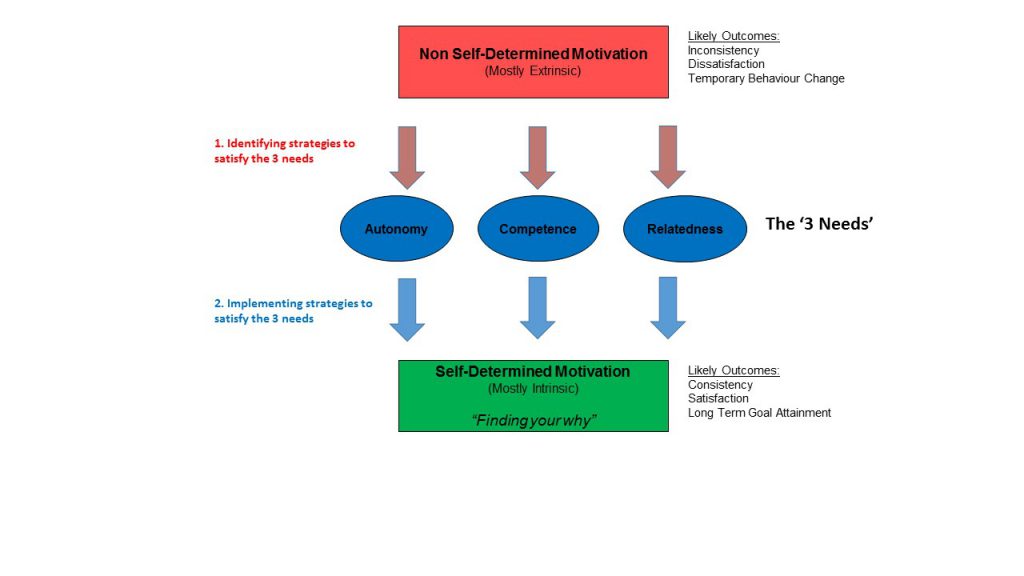Figuring out why you should exercise may be the most important step in your health and fitness journey. Motivation can be a difficult thing to pin down, some weeks we have an insatiable drive to exercise (first week of the year, anyone?) and others we can barely be dragged into the gym. This isn’t uncommon, but ideally we want to get to the stage where showing up becomes unconditional. This is when we’ve found our ‘why’. There is a large body of research into motivation which can not only can give us a framework to understand our personal motivational state but also insight into how to improve it. The self-determination theory from the world of psychology is a powerful tool that can be used to explain motivation and how we can instigate long-term behaviour change.
Self-determined motivation is also referred to as autonomous or intrinsic motivation. Basically, you’re engaging in a behaviour because you want to and find it inherently enjoyable. Non self-determined motivation, or controlled motivation, is where you’re doing an activity because you feel you have to. Often you’re trying to please somebody else or you’re interested in some sort of external reward. This form of motivation is extrinsically driven. Being extrinsically motivated is not necessarily a bad thing and the two forms aren’t mutually exclusive. It’s quite common to intrinsically enjoy exercising, but to also be motivated by the positive effects that it has on how you look and feel. However, research has shown that increasing the intrinsic self-determined motivation for an activity will improve the likelihood of long term behaviour change, goal attainment and overall satisfaction. So how can we move towards a more intrinsically oriented form of motivation?
 There is strong evidence that a set of universal human needs exist that need to be satisfied for optimal psychological health. These needs being autonomy, competence and relatedness. Autonomy is the perception of being the origin of your own behaviour, competence refers to the feeling of being effective in producing a desired outcome, while relatedness refers to the feeling of being respected, understood, and cared for by others. If these three needs are satisfied during a particular activity, then the likelihood of attaining long-term self-determined motivation will be maximised. Attaining a self-determined motivational state (i.e. a very strong ‘why’) will improve your chances of a life-long training habit and the associated benefits. The first step is to identify strategies which you use to satisfy the three needs, this will be somewhat personal but there are some general strategies we can use:
There is strong evidence that a set of universal human needs exist that need to be satisfied for optimal psychological health. These needs being autonomy, competence and relatedness. Autonomy is the perception of being the origin of your own behaviour, competence refers to the feeling of being effective in producing a desired outcome, while relatedness refers to the feeling of being respected, understood, and cared for by others. If these three needs are satisfied during a particular activity, then the likelihood of attaining long-term self-determined motivation will be maximised. Attaining a self-determined motivational state (i.e. a very strong ‘why’) will improve your chances of a life-long training habit and the associated benefits. The first step is to identify strategies which you use to satisfy the three needs, this will be somewhat personal but there are some general strategies we can use:
-
Competence:
Goal setting is crucial to any strength and conditioning program and is especially useful in building a sense of competence. If you ensure that you 1. have a goal and, 2. set a goal that is specific, measurable, achievable, realistic and has a clear timeframe (S.M.A.R.T) you will be on your way to improving a sense of competence.
-
Autonomy:
Having a written program to record all of the key variables from training will aid in developing a sense of control or autonomy. Having a personal understanding and investment in the program will provide ownership that can be built over time. Having a qualified trainer to write your program is a great start, but it’s imperative to take the time to educate yourself on the rationale behind your program. This aligns nicely with goal setting above, having quantitative data behind your training can explain why you are, or why you’re not, achieving your goals.
-
Relatedness:
Find somebody to share the journey with. Having a training partner or group is a great strategy if you enjoy the company of others while at the gym. If you’re not into that sort of thing and prefer to train alone, having a ‘distance’ training partner or group that you check in with from time to time is a great way to reinforce accountability and provide a sense of relatedness.
Once you have identified the appropriate strategies for you the second (and crucial) step is implementation. Finding your personal ‘why’ will have you well on your way to attaining your long term goals in a way that is intrinsically satisfying.

Figure 1. Using the self-determination theory to find your ‘why’.





































